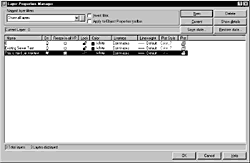Standardizing Layer Names
Whether you’re the only person working with AutoCAD in your company, or one of several dozen, establishing standard layer names can increase your efficiency in layer management. By using layers to organize various elements in your drawing, you simplify the process of displaying the desired elements, which makes editing and plotting easier. For example, if your drawing has gas lines and sewer lines, but you only want to edit the gas lines, you can make your drawing visually easier to work with by turning off the layer on which the sewer lines were drawn.
Not only does organizing your drawing’s elements by layers make editing and plotting easier, it also reflects on your level of skill as an AutoCAD technician. By following a preset layering standard and using it to organize objects in your drawing, you demonstrate your understanding of the importance of proper layer and object management. For example, the ability to quickly control which groups of objects are displayed by turning certain layers off or on can dramatically increase productivity, which demonstrates that you know what you’re doing with AutoCAD.
Layer Name Considerations
The process of defining standard layer names can be daunting. Because the drawing you are creating represents only one portion of the project’s life cycle, you must consider not only the number of layers and their names necessary to fulfill your needs, but also how many ways your drawing will be used by others. For example, will half-scale versions of your drawing be inserted into reports? If so, it may be necessary to place duplicate text on two different layers: one layer to hold text that is easy to read at full scale, and the other layer to hold duplicate text that is easily read at half scale. Will other departments or companies incorporate your drawing into theirs, creating a composite drawing? If so, you must establish layering standards that you both find acceptable. What different objects must you display on the set of hardcopy plots provided to the contractor for construction? Although a single model space drawing may contain both gas lines and sewer lines, your hardcopy plots must separate these two components, creating one set of plots showing only gas lines, and the other showing only sewer lines. Your understanding of the many ways your drawing will be used, and whether you properly develop and use layering standards, can make fulfilling all needs during a project’s life cycle productively easy, or disastrously difficult.
Predefined Standards
Although there are many things you must consider when developing layer standards, the good news is that in reality, you probably don’t have to do too much. Because AutoCAD has been around for nearly two decades, many companies have established their own internal layering standards. As a consequence, when you work for a company, you are typically issued a CAD Standards Manual, and are required to read it and use it in your day-to-day drafting activities. By using the company’s layering standards, you ensure uniformity with all drawings.
Note
For information on A/E/C CAD layering guidelines, browse E-Architect’s Web site at www.e-architect.com, and search using the keyword “LAYER.”
In addition to the layering standards, many companies have created drawing template files that already contain the proper layers. By using template files when starting a drawing, you are guaranteed that your drawing file has the layers you need, with each layer preset to the correct properties of color, linetype, and lineweight. You can learn more about creating your own drawing templates in Chapter 2, “Starting a Drawing in AutoCAD 2002,” in the section “Customizing and Saving a Template File.”
Extended Layer Names
In releases prior to AutoCAD 2000, when considering layering standards, the limitations imposed by AutoCAD were factored into the process. Previously, AutoCAD limited layer name lengths to 31 characters. Additionally, mixed casing of characters was ignored, and spaces were not allowed. These restrictions not only imposed limitations on creating descriptive layer names, but they often created problems when attaching xrefs because AutoCAD added the xref’s drawing name to the beginning of xref-dependent layers, which made it easy to exceed the 31-character limit. This in turn caused AutoCAD to abort opening the drawing.
With AutoCAD 2000, AutoCAD extended the allowable length of layer names substantially. Layer names can now be 255 characters long if needed. They can also include spaces, and AutoCAD preserves upper- or lowercasing of characters. With these enhancements, you can develop more meaningful, descriptive layer names.
Note
Although xref names are still appended to the beginning of xref-dependent layers, the xref’s drawing name does not count toward the 255-character limit.
Although the extended features of layer names are good, you should use discretion when creating layering standards. For example, Figure 4.2 shows two different methods of using the new extended layer name features. The layer name on the bottom of the list reads, This is the layer on which I placed all the existing sewer line text., and actually includes the period at the end. This layer name may be very descriptive, but it’s not very practical in terms of layer name standards.
Figure 4.2. The Layer Properties Manager allows for long layer names.

For example, if your drawing contains dozens, or even hundreds of layers, it is not easy to scroll down the list of layer names and locate the one for existing sewer line text because the layer name is so long. In contrast, the layer name in the middle of the list reads, Existing Sewer Text. This much shorter name relates the same information as its much longer counterpart, and allows users to easily peruse the layer list and find the correct layer. Because AutoCAD allows you to display names alphabetically, you can find the layer that holds existing sewer text by looking for it alphabetically. Additionally, this shorter version makes it easier to isolate the display of layer names using the Layer Properties Manager’s layer filters, a feature described later in this chapter.
